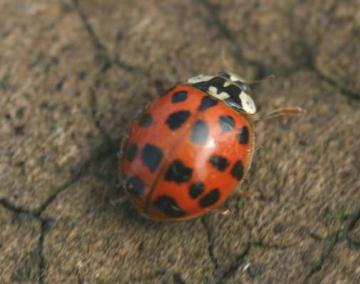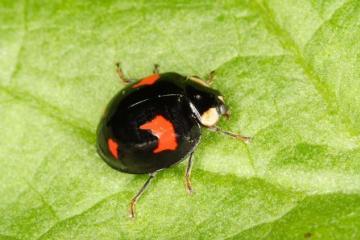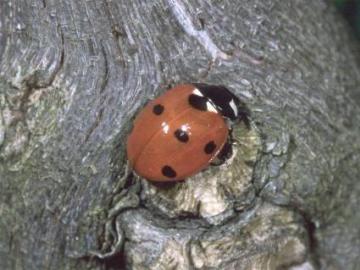Harlequin Ladybird
Harlequin Ladybird Harmonia axyridis - a potential ecological disaster in Britain?
by Paul Mabbott
We noted (Newsletter May, 2004) that "new" ladybirds were likely to be found in Britain and expressed concern about one species. Harmonia axyridis (the multicoloured, multivariate, southern, Japanese, harlequin, hallowe'en, Asian ladybird,-beetle,-bug) was introduced into SE USA to control pest aphids: it is a very efficient at this but has some less fortunate properties.
Like most ladybirds it can reproduce at a prodigious rate so millions are regularly seen, often entering buildings and becoming a nuisance. It has spread throughout the USA and Canada.
More significantly, it has a very wide prey range: if there are no aphids it will eat other insects including ladybirds. Most native ladybirds are 'cannibals' but, since species eat each other, there is a balance without net gain or loss between species. Unfortunately, other ladybirds cannot eat H. axyridis because of its chemical defences; as a result native American species are in decline from both competition and predation. Other insects are also eaten including butterfly eggs: it is not only ladybirds which are threatened.In its native ecosystem, H. axyridis is a harmless, helpful ladybird because its population level is controlled by predators and pathogens. These do not exist in America or Europe. To release the animal in America was foolish. Worse was to allow its use as a pest control in Europe: it is now established, particularly in Holland where it seems to be elbowing out local ladybirds. On the scale of continental America and Europe the species is a big problem: it could be a disaster if released onto a small island.
The first British record of the species has come from north Essex: Ian Wright found it in the garden of the White Lion at Sible Hedingham. It was hoped that this was an isolated vagrant, but within weeks mor ehave been found over the S.E., particularly in London. It is important that we look out for this beetle. It is not possible to illustrate all the forms of H. axyridis (it is likely to be found in mixed groups). It may be red with between 0 and 19 black spots (small or large) but is commonly melanic, black with variable numbers of red spots. However, pattern is not too important since it is a relatively large species (7mms +), is somewhat rounded, with brown legs. The only British red-black ladybirds of this size are the 7-spot and Eyed ladybirds which have black legs. Melanic variant native ladybirds of this size are extremely rare.
- J. Bowdrey Curator of Natural History Colchester Museums, 14 Ryegate Road Colchester Essex CO1 1YG (Tel: 01206 282936)
- Paul Mabbott, 49 Endowood Road, Sheffield S7 2LY
- or to any other entomologist!
I have a web page which is regularly up-dated at:
http://www.ladybird-survey.pwp.blueyonder.co.uk/H_axyridis.htm
My thanks to the late Michael Majerus for notification of this record and for other information.




















